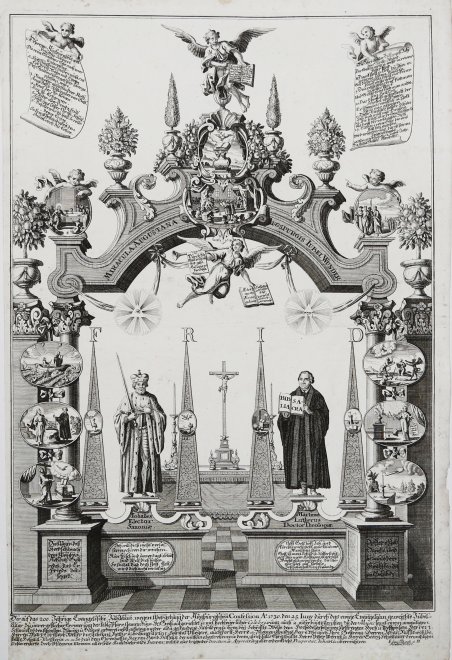Dettagli
Anno di pubblicazione
1730
Descrizione
Foglio commemorativo della Confessione di Augusta con allegoria. Da un disegno di Johann Lorenz Haid (Kleineislingen 1702 – Augsburg). Acquaforte, 1730, firmata nella lastra in basso a destra. Foglio allegorico che commemora il 200° anniversario della Confessione di Augusta sotto l'imperatore Carlo V (1530). Comprende un ricchissimo apparato allegorico, con le figure dell’imperatore Giovanni Federico I, Elettore di Sassonia e quella di Martin Lutero. La Confessione di Augusta, detta anche Confessione augustana (nell'originale latino Confessio augustana) e più raramente Confessione di Asburgo (per l'erronea traduzione del nome della città tedesca di Augsburg, in italiano Augusta), è la prima esposizione ufficiale dei princìpi del protestantesimo che sarà poi detto luterano, redatta nel 1530 da Philip Melanchthon per essere presentata alla dieta di Augsburg (città del Sacro Romano Impero) alla presenza di Carlo V. A tutt'oggi è considerata uno dei testi base delle Chiese protestanti di tutto il mondo e fa parte del Liber Concordiae luterano. Bellissima prova, impressa su carta vergata coeva, con margini, in ottimo stato di conservazione. Augsburg Confession commemorative sheet with allegory. Etching, 1730, signed in the plate at lower right. Allegorical sheet commemorating the 200th anniversary of the Augsburg Confession under Emperor Charles V (1530). Includes a very rich allegorical apparatus, with the figures of Emperor John Frederick I, Elector of Saxony, and that of Martin Luther. The Augsburg Confession, also known as the Augustan Confession or the Augustana from its Latin name, Confessio Augustana, is the primary confession of faith of the Lutheran Church and one of the most important documents of the Protestant Reformation. The Augsburg Confession was written in both German and Latin and was presented by a number of German rulers and free-cities at the Diet of Augsburg on 25 June 1530. The Holy Roman Emperor, Charles V, had called on the Princes and Free Territories in Germany to explain their religious convictions in an attempt to restore religious and political unity in the Holy Roman Empire and rally support against the Ottoman invasion in the 16th-century Siege of Vienna. It is the fourth document contained in the Lutheran Book of Concord. Beautiful proof, printed on contemporary laid paper, with margins, in good condition. Cfr.

Scopri come utilizzare
Scopri come utilizzare

